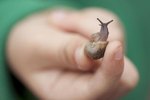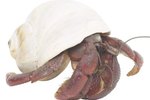
Being sociable and lively, hermit crabs certainly make appealing pets, but aren’t really the low-maintenance animals certain unscrupulous sellers make them out to be. They need the right habitat, diet, accessories and daily care. They also live longer than you might expect -- for at least five years and sometimes 25 or more -- so think carefully about the time commitment before rushing home with a box full of crabs.
Choosing Your Crabs
Both land and aquatic species have highly specific habitat requirements, and the latter need an established saltwater aquarium. Beginners would be well advised to opt for terrestrial hermit crabs, as maintaining a marine aquarium requires some expertise. Several species of land hermit crabs appear in the pet trade, all with slightly different requirements, so research the species you wish to keep before setting up their home. Among the most widely available species and the most suitable for beginners are the Caribbean hermit crab (Coenobita clypeatus) and the Ecuadorian (Coenobita compressus). Other land hermit crabs occasionally appear for sale, but they tend to be more delicate.
The Perfect Home
These crabs are active and sociable, so adopt more than one. Accordingly, get the largest glass or plastic tank possible. The absolute minimum is 10 gallons, which could house two small crabs, but you’re better off with a 20-gallon or larger tank. Other essentials are two water bowls, one for salt water and one for fresh, a food saucer, a heat source, sponges, shells, sand or another suitable substrate, a shelter, a plant mister and something for the crabs to climb on, such as twigs or baskets.
Heat and Humidity
Check the exact requirements of your species, but the hermit crabs you’re most likely to have need a warm damp habitat, with a temperature of about 75 to 85 degrees Fahrenheit and a relative humidity of about 75 percent. Use a hygrometer to monitor the humidity and a thermometer for temperature. Misting the tank and substrate increases the humidity instantly, while additional damp sponges help maintain it. Additional heat can be supplied with a heat bulb (not a heat lamp for reptiles, which is dangerous for hermit crabs) or a heat mat underneath one side of the tank.
Mobile Homes
As your hermit crabs grow, they’ll need bigger shells, so provide a selection of shells slightly larger than the ones they already have. As with other decorations, sterilize the shells before offering them to your crabs. Boiling tends to be the easiest and safest way to do this. Brush off any dirt and debris first. Use a glass pan if possible and boil the shells for at least 20 minutes.
Crab Cuisine
Hermit crabs are omnivores, consuming a great range of plant and animal foods. A commercial hermit crab food makes a good basic diet, but supplement it with fresh vegetables, whole grains and small amounts of meat, fish or boiled egg. Use a calcium supplement for crabs as per the instructions -- like other arthropods, hermit crabs need a lot of calcium to form their hard exoskeletons. Along with a varied diet, hermit crabs need water, both fresh and salt. Always use dechlorinated or bottled water for your pets, not water straight from the tap. Use an aquarium salt mix to make up water for the salt water bowl, which hermit crabs need to maintain the right salinity in their bodies. If you have small crabs, place sponges in the water bowls so your pets don’t drown.
References
Resources
Photo Credits
-
Jeffrey Hamilton/Lifesize/Getty Images
Writer Bio
Judith Willson has been writing since 2009, specializing in environmental and scientific topics. She has written content for school websites and worked for a Glasgow newspaper. Willson has a Master of Arts in English from the University of Aberdeen, Scotland.




